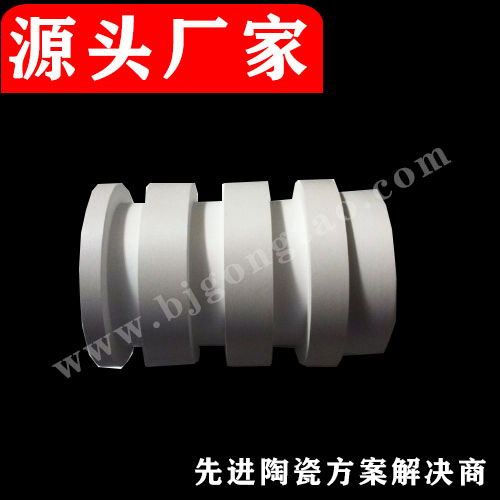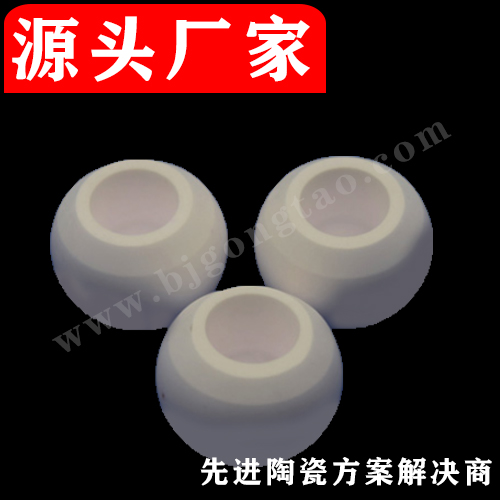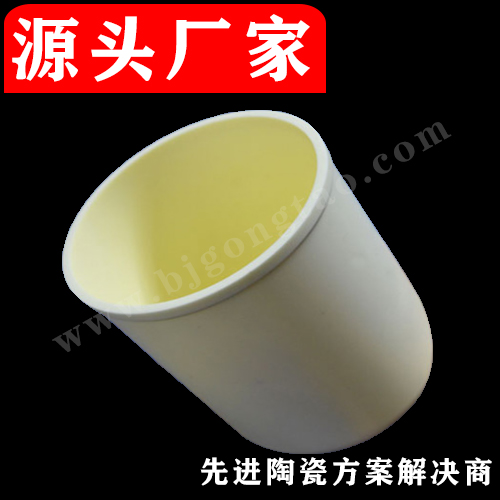News
Contact Us

Suzhou Kaifa New Material Technology Co., Ltd.
Email:heqing@szkfxc.com
Email:sales@szbknm.com
Email:bkxc.bonnie@gmail.com
location:Home » News » Kaifa News
Performance and application of common ceramic materials
edit:Kaifa Popularity:2835 Time:2020/3/28
Abstract: Ceramic materials have different properties due to different composition elements. As a structural material, they have been widely used in various industries.
(I. Introduction
In the late 20th century, with the rise of many new technologies (such as electronic technology, space technology, laser technology, computer technology, etc.), as well as basic theory (such as mineralogy, metallurgy, physics, etc.) and testing technology (such as electron microscope technology, With the development of X-ray diffraction technology and various spectrum analyzers, people have a deep understanding of the relationship between material structure and performance. By controlling the chemical composition and microstructure of the material, many ceramic materials with different properties have been developed, such as various functional ceramics (electronic materials, optical fibers, sensitive ceramic materials) and high-temperature structural ceramics. Compared with traditional ceramic materials, its strength has been increased by hundreds or thousands of times, coupled with the excellent high temperature resistance, wear resistance, corrosion resistance, insulation and other characteristics of the ceramic material itself, which has made it more and more important in many important areas. More and more widely used.
Commonly used high-end ceramic materials mainly include: compounds composed of metals (transition metals or similar metals) and non-metal elements such as boron, carbon, silicon, nitrogen, and oxygen, and compounds composed of non-metal elements such as boron and silicon Carbides and nitrides.
According to its element composition, it can be divided into: oxide ceramics, nitride ceramics, carbide ceramics, silicide ceramics and boride ceramics. In addition, glass ceramics have also been widely used as structural materials in recent years.
(Two) oxide ceramics
The atomic bonding of oxide ceramic materials is dominated by ionic bonds, and there are some covalent bonds, so it has many excellent properties. Most oxides have a very high melting point, good electrical insulation properties, especially excellent chemical stability and oxidation resistance, and have been widely used in the field of the upper process.
(1) Alumina ceramics
Alumina ceramics, also known as corundum ceramics, generally have α-A1203 as the main crystal phase. There are different series according to the content of A1203 and the additives. For example, it can be divided into 75 porcelain, 85 porcelain, 95 porcelain, 99 porcelain, etc. according to the content of A1203; it can be divided into mullite porcelain, corundum-mullite porcelain, and corundum porcelain according to the main crystal phase; according to the different additives Divided into chrome corundum, titanium corundum and so on.
Al203 ceramic is one of the most stable chemical properties and the highest mechanical strength among refractory oxides; A1203 ceramic does not reflect with most molten metals, only Mg, Ca, Zr and Ti have a reducing effect above a certain temperature; thermal Sulfuric acid can dissolve A1203, and hot HCl and HF also have a certain corrosive effect on it; the vapor pressure and decomposition pressure of A1203 ceramics are the smallest. Due to the excellent chemical stability of A1203 ceramics, it can be widely used in acid-resistant pump impellers, pump bodies, pump covers, shaft sleeves, pipe linings and valves for acid transportation.
Al203 ceramics with alumina content higher than 95% have the characteristics of excellent electrical insulation performance and low dielectric loss, so they have a very broad application area in electronics and electrical appliances.
The high hardness and wear resistance of A1203 ceramics have been widely used in the mechanical field. Such as manufacturing textile wear-resistant parts and knives. A1203 ceramic spark plugs are also widely used in various engines.
Transparent Al203 ceramics have good permeability to visible light and infrared light, and at the same time have high temperature strength, good heat resistance, strong corrosion resistance and other characteristics. It can be used to make high pressure sodium lamps, infrared detection window materials, etc.
(2) Zirconia (Zr02) ceramics
Zr02 has two kinds of zirconium allotrope cubic structure (c-phase), tetragonal structure (t-phase) and monoclinic structure (m-phase). According to the composition of the phases, Zr02 ceramics can be divided into stable Zr02 ceramic materials and partially stable Zr02 ceramics.
Ⅰ stabilized Zr02 ceramics
Stable Zr02 ceramics are mainly composed of cubic phases, which have high fire resistance, small specific heat and thermal conductivity, and are ideal high-temperature insulation materials. They can be used as high-temperature furnace linings and as various heat-resistant coatings.
Stable Zr02 ceramics have good chemical stability. They can still resist the corrosion of acid and neutral substances at high temperatures, but they cannot resist the corrosion of alkaline substances. Group V, VI, and VII metal elements in the periodic table do not react with it and can be used as crucibles for smelting this metal.
Pure Zr02 is a good insulator. Due to its obvious high-temperature ion conductivity, it can be used as a heating element at 2000 ° C, a high-temperature electrode material, and a lamp that generates ultraviolet rays.
In addition, by using the stable oxygen ion conduction characteristics of Zr02, an oxygen sensor can be made to measure the oxygen concentration.
Ⅱ Partially stabilized Zr02 ceramics
Partially stabilized Zr02 ceramics are composed of tc dual-phase structure, which has very high strength, fracture toughness and thermal shock resistance, and is called "ceramic steel". At the same time, its thermal conductivity is small, its thermal insulation effect is good, and its thermal expansion coefficient is relatively large. It is relatively easy to match with metal parts. It is used in the cylinder wall, piston and cylinder cover parts of ceramic engines developed recently.
Partially stabilized Zr02 ceramics can also be used as non-lubricating bearings in the mining and mineral industries, nozzles for sand blasting equipment, components used in powder metallurgy industry, stamping dies for pharmaceuticals, etc.
In addition, partially stabilized Zr02 ceramics can also be used as a variety of high toughness, high strength industrial and medical equipment. Such as the textile industry doffing machine scissors, wool shears, scissors in the production of tapes, microelectronics industry tools, in addition, because it does not react with living organisms, it can also be used as a bioceramic material.
(3) MgO ceramic
The main crystal phase of MgO ceramics is MgO, which belongs to the cubic sodium chloride structure. It has a melting point of 2800 ° C and a theoretical density of 3.58 g / cm2. It has high specific volume resistance at low temperatures, low dielectric loss, and a good dielectric constant of 9.12. Insulation, belongs to weak alkaline substance. MgO has a strong resistance to corrosion of alkaline metal slag. It does not work with magnesium, nickel, uranium, thorium, aluminum, molybdenum, etc. It can be used to prepare crucibles for melting metal, molds for pouring metal, and protection of high temperature thermocouple Tubes, lining materials for high temperature furnaces, etc.
(Three) nitride ceramics
Nitrides include non-metallic and metallic element nitrides, which are high melting point substances. There are many types of nitride ceramics, but they are not natural minerals, but are artificially synthesized. Recently, industrially used nitride ceramics include silicon nitride (Si3N4), boron nitride (BN), aluminum nitride (AlN), and titanium nitride (TiN).
(1) Silicon nitride (Si3N4) ceramics
Si3N4 ceramic material has a small thermal expansion coefficient, so it has good thermal shock resistance. Among ceramic materials, Si3N4 has a high bending strength and high hardness. At the same time, it has self-lubricity and a small friction coefficient. Similarly, the use of mechanical wear-resistant materials has great potential; Si3N4 ceramic materials have a higher room temperature resistivity and can be used as better insulation materials; Si3N4 ceramics are resistant to all inorganic acids except hydrofluoric acid and certain alkaline solutions. It is not infiltrated and corroded by molten metal alloys such as lead, tin, silver, brass, and nickel; a silicon oxide film formed on the surface of the material during high-temperature oxidation can prevent further oxidation, and the resistance temperature is 1800 ° C.
Si3N4 ceramics can be used as thermomechanical materials, cutting tools, advanced refractory materials, and can also be used as corrosion-resistant and wear-resistant sealing parts.
(2) Aluminum nitride (AlN) ceramics
AIN is a covalent bond compound, hexagonal system, wurtzite type structure, white or off-white, density 3.26g / cm2, no melting point, sublimation decomposition at 2200 ℃ -2250 ℃, high thermal hardness, even before the decomposition temperature Does not soften deformation. Has excellent thermal shock resistance. AlN has good corrosion resistance to Al and other molten metals, arsenic, etc., especially has excellent corrosion resistance to molten Al liquid, and also has excellent electrical insulation and dielectric properties; but the high temperature of AlN Poor oxidation resistance, easy to absorb moisture and hydrolysis in the atmosphere.
AlN can be used as a crucible for molten metal, a thermocouple protection tube, a container for vacuum evaporation, a container for gold evaporation in a vacuum, a heat-resistant brick, etc. It is especially suitable as a lining material for oxidizing electric furnaces around 2000 ° C. ; The thermal conductivity of AlN is 2-3 times that of A1203, and the strength is higher than that of Al203 when hot-pressed. It can be used in high-strength, high-thermal-conduction occasions, such as large-scale integrated circuit substrates.
(3) Boron nitride (BN) ceramics
Boron nitride (BN) ceramics have two types of BN materials: hexagonal and cubic structures.
Hexadecimal BN
Hexagon BN is self-lubricating and can be used for mechanical seals, high-temperature solid lubricants, and also as bearings made of metal and ceramic fillers. Its heat resistance is very good, and it can be used in an oxidizing atmosphere below 900 ° C and a nitrogen and inert atmosphere below 2800 ° C. Liuli BN has good corrosion resistance to acid and alkali and glass slag, and neither wets nor reacts with most molten metals, so it can be used as crucibles, vessels and other components for smelting non-ferrous metals, precious metals and rare metals. . BN is both a good conductor of heat and an electrical insulator. Its breakdown voltage is 4-5 times that of alumina and its dielectric constant is 1/2 that of alumina. It can be used as insulation material for ultra-high-voltage wires. BN is transparent to microwave and infrared and can be used as a window for infrared and microwave transmission. BN is stable under ultra high pressure and can be used as a pressure transmitting material and container. BN is the lightest ceramic material and can be used in high temperature structural materials for aircraft and spacecraft. In addition, the light-emitting property of BN can be used as an electroluminescent material. Amorphous carbon fiber coated with BN can be used in rocket nozzles and the like.
Lili BN
Cubic BN is a sphalerite structure with high chemical stability, good thermal conductivity and heat resistance. Its hardness is similar to that of artificial diamond, and it is an abrasive material with excellent performance. Compared with diamond, its most prominent advantage is that it does not react with iron-based metals at high temperatures and can be used at a temperature of 1400 ° C.
In addition to being directly used as abrasives, Lili BN can also be mixed with certain metals or ceramics and sintered to make block materials, which are used as various high-performance cutting tools.
(Four) carbide ceramics
Typical carbide ceramic materials include silicon carbide (SiC), boron carbide (B4C), titanium carbide (TiC), zirconium carbide (ZrC, etc.), and the common feature of carbides is their high melting points. The melting points of many carbides are above 3000 ° C. Carbides are oxidized at very high temperatures, but many carbides have better oxidation resistance than high melting metals such as W and Mo. Most carbides have good electrical and thermal conductivity. Many carbides have very high hardness, especially the hardness of B4C is second only to diamond and cubic boron nitride, but the brittleness of carbides is generally greater.
(1) Silicon carbide (SiC) ceramics
Silicon carbide has no melting point and decomposes at 2500 ° C under normal pressure. The hardness of silicon carbide is very high, Mohs hardness is 9.2-9.5, microhardness is 33400MPa, second only to a few substances such as diamond, LiN BN and B4C.
The thermal conductivity of silicon carbide is very high, about twice that of Si3N4; its thermal expansion coefficient is about 1/2 of that of A1203; its bending strength is close to that of Si3N4 materials, but its fracture toughness is smaller than that of Si3N4; it has excellent high temperature strength and high temperature resistance Creep ability, the bending strength of hot-pressed silicon carbide material at 1600 ℃ is basically the same as room temperature; the thermal shock resistance is good. It has high chemical stability and is insoluble in general acids and mixed acids.
Oxide, nitride and silicon carbide materials have been used on a large scale for furnace structural materials, flame barriers, furnace tubes, furnaces, etc. in metallurgy, light industry, machinery, building materials, environmental protection, energy and other fields; heat generation from carbide materials The components are gradually heating the main components in an oxidizing atmosphere below 1600 ° C; high-performance silicon carbide materials can be used for high-temperature, wear-resistant and corrosion-resistant mechanical parts; silicon carbide materials are also used to make rocket exhaust nozzle high-performance heat exchangers. In addition, silicon carbide is an important candidate material for various high-temperature gas turbine high-temperature components to improve performance.
(2) Boron carbide (BC) ceramics
The outstanding features of boron carbide are high melting point (about 2450 ℃); low specific gravity, its density is only 1/3 of steel; low expansion coefficient; high thermal conductivity; high hardness and high wear resistance, its hardness is only lower than diamond and cubic BN; high strength and a certain fracture toughness, the flexural strength of hot-pressed B4C is 400-600MPa, the fracture toughness is 6.0MPa.ml/2; it has a large thermal electromotive force (100 μV / k), which is a high temperature P Type semiconductor, with the decrease of carbon content in B4C, it can be transformed from P type semiconductor to N type semiconductor; it has a high neutron absorption cross section.
B4C has excellent performance, in addition to a large number of abrasives, it can also produce a variety of wear-resistant parts, thermocouple elements, high temperature semiconductors, thermoelectric conversion devices on spacecraft, bulletproof armor, reactor control rods and shielding materials.
(V) Glass ceramic materials
The glass with a specific composition (containing a nucleating agent) is subjected to crystallization heat treatment, and a large number of minute crystals are uniformly precipitated inside the glass and further grown to form a dense microcrystalline phase. The glass phase is filled in the grain boundaries to obtain a polycrystalline solid like ceramic Materials are collectively called glass ceramics, also known as glass-ceramics.
(1) Low expansion glass ceramic
The characteristics of this type of glass ceramic are that its microstructure is frame-shaped silicate, and the main crystal phases are β-quartz, β-potassite, and β-potassite, which have low thermal expansion coefficients (which can be negative), High strength, good thermal stability, high use temperature and other characteristics, and can be made into two types of transparent and cloudy white. The low expansion coefficient is very advantageous for the dimensional stability and thermal shock resistance of the component, so it can be used as a part with high dimensional stability requirements on the space shuttle. Low-expansion glass-ceramics are currently the largest produced glass-ceramics, and are widely used in the production of various advanced cookers, high-temperature operation observation windows, microwave oven covers, support rods for large astronomical telescopes and laser mirrors, laser components, and important parts on space shuttles. Parts.
(2) Glass ceramics can be strengthened on the surface
The strength of glass ceramics is several times greater than that of ordinary glass, and the flexural strength can reach 88-250MPa, but it still cannot meet the requirements in some special occasions, and the strength needs to be further improved. Since the damage of brittle materials mostly originates from surface microcracks, a method of introducing a compressive stress thin layer on the surface of the glass-ceramic material can be used to prevent the surface microcracks from expanding, thereby improving the strength of the material. There are two commonly used methods. One is to introduce the surface compressive stress layer using the difference between the surface layer and the internal thermal expansion, and the other is to introduce the surface compressive stress layer using ion exchange.
(3) Machinable glass ceramics
The main reason for easy machining of machinable glass ceramics is that the main crystal phase is a fluoromica structure. It has been found that there are three main types of fluoromica in machinable glass ceramics: fluorophlogopite, tetrasilicone mica and lithium mica. Because mica flakes are easy to cleave, this unique microstructure allows mica-containing glass ceramics to be processed to precise dimensions using ordinary drills, saws or turning, grinding, etc. Machinable glass ceramics with fluoromica as the main crystal phase have high thermal shock resistance, excellent insulation properties, high dielectric strength, and low dielectric loss. Alkaline earth mica processable glass ceramics have higher toughness, higher thermal stability (> 1100 ° C) and insulation. Therefore, machinable glass ceramics have broad application prospects in the fields of electrical insulation, microwave technology, precision instruments, and aviation and aerospace.
Ceramic materials composed of different elements have different application fields. In general, the development trend of ceramics in the future is mainly the exploration of materials with high ductility, ultra high strength, ultra high toughness, ultra high hardness and high temperature resistance. Specifically, the main Have:
1) Development towards multi-layer, multi-phase composite ceramics; strengthening and toughening from fiber toughening whisker toughening, particle dispersion strengthening, phase change toughening, etc. to synergistic toughening;
2) Development towards nano-ceramics;
3) Strengthen the tailoring and design of ceramic materials, such as grain boundary and interface design, grain orientation design, composite design between multiple phases, bionic structure design, etc .;
4) High-performance porous ceramic materials;
5) Breakthrough in low-cost, high-performance advanced ceramic preparation technology.
Next:
Dingsheng Cerami...
Previous:
High purity prod...





